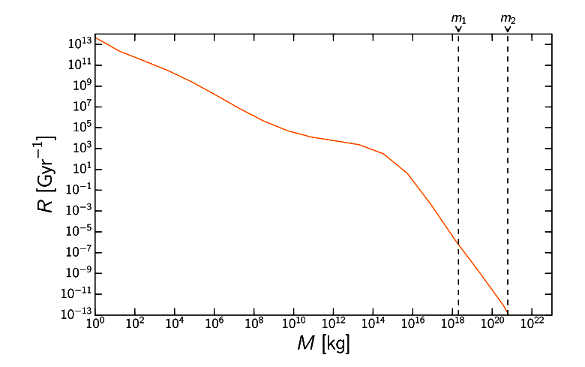Tardigrades
August 14, 2017
There's a common conception that
cockroaches will
inherit the
Earth.
Humans,
genus Homo, have existed since the appearance of
Homo habilis, about two or three million years ago. Cockroaches, however, date back about 300 million years, to the
Carboniferous period.
Cockroaches are a hardy
insects that are able to survive for a month without
food. They can survive without
air for more than half an hour, and they're
immune to below
freezing temperatures for hours at a time. What gives them a definite survival advantage is their
radiation resistance, leading to their supposed resilience from a
nuclear war. While the direct radiation from a nearby
gamma ray burst, shielded by the
atmosphere, would not reach
Earth's surface, humans might not survive the
environmental effects of such a radiation burst, but cockroaches might.

One of many species of the cockroach.
This is the Ectobius vittiventris, first described by A. Costa in 1847.
(Wikimedia Commons image by Amada44.)
One interesting part of cockroach
history was the first
birth in
space of a terrestrial
organism, the 33 offspring of a
Russian cockroach named
Nadezhda. This occurred in 2007 on the
Foton-M 3 bio-satellite. Back on Earth, the
offspring of Nadezhda's offspring were found to develop normally.
Recent
research has shown that cockroaches might not be the front-runners for terrestrial succession. The new contenders are the
tardigrades, also called "water bears" because of the superficial resemblance (see figure). Tardigrades are
eight-legged,
segmented,
water-dwelling micro-animals first discovered by the
German zoologist,
Johann August Ephraim Goeze, in 1773. They are just a half
millimeter long, and tardigrade
fossils have been found in
Cambrian period deposits, dating to 530 million years ago. Tardigrades are ubiquitous, being found in environments ranging from the
deep sea, to
tropical rainforests, to
Antarctica.

Animal, vegetable, or mineral? an scanning electron microscope micrograph of a Milnesium tardigradum Schokraie (left), and a photo of a generic "water bear" (right). (Left image from E. Schokraie, U. Warnken, A. Hotz-Wagenblatt, M.A. Grohme, S. Hengherr, et al., "Comparative proteome analysis of Milnesium tardigradum in early embryonic state versus adults in active and anhydrobiotic state," PLoS ONE, vol. 7, no. 9 (September 27, 2012), article n. e45682, doi:10.1371/journal.pone.0045682, and right image by Aditya Sainiarya, both via Wikimedia Commons.)
Tardigrades have been found to be the most resilient animals known, with some tardigrade species surviving at
liquid helium temperatures (4
kelvin), and others surviving for a few minutes at 150
°C. The deep ocean tardigrade species survive at
pressures greater than those found in deep ocean tranches, more than a thousand
atmospheres of pressure. They are also resistant to ionizing radiation at hundreds of times the
lethal dose for humans, and they survive the
vacuum of outer space. Tardigrades can survive without food or water for more than 30 years, after which time they can
forage and
reproduce after
hydration.
Scientists at the
University of North Carolina (Chapel Hill, NC), the
University of California (Berkeley, California), and the
University of Modena and Reggio Emilia (Modena, Italy) investigated the mechanism by which tardigrades are able to
survive desiccation for many years.[1-2] They found that
intrinsically disordered proteins are enriched during tardigrade desiccation, and these proteins, which
vitrify, increase their desiccation tolerance.[1] says
Thomas Boothby, a
postdoctoral fellow at the University of North Carolina, and the study's first
author,
"The big takeaway from our study is that tardigrades have evolved unique genes that allow them to survive drying out... In addition, the proteins that these genes encode can be used to protect other biological material--like bacteria, yeast, and certain enzymes--from desiccation."[2]
It had always been assumed that this ability to survive desiccation came from
trehalose, a
sugar that aids desiccation survival in yeast,
brine shrimp, and some
nematodes.[2] Trehalose works by forming
glass-like solids, rather than
crystals, when they dry.[2]
DNA sequencing, however, showed that tardigrades do not produce trehelose, so these researchers looked for another mechanism, which turned out to be intrinsically disordered proteins, which have no fixed
three-dimensional structure.[2]

Structural diagram of trehalose.
(Wikimedia Commons image by Fvasconcellos.)
To verify this mechanism, the research team inserted protein-encoding genes into yeast and other bacteria, and these organisms were also protected from desiccation.[2] There's great utility in this finding, since the same mechanism might be used to make
crops drought-resistant. It might also allow stabilization of sensitive
pharmaceuticals in a dry state, so they would not need to be
refrigerated.[2]
Such proteins that resist crystallization are likely responsible for the cold endurance of tardigrades. In a 2016 study,
Japanese scientists from the
National Institute of Polar Research (NIPR, Tokyo, Japan) and
Sokendai (The Graduate University for Advanced Studies, Tokyo, Japan) examined the survival of revived tardigrades of the species,
Acutuncus antarcticus, retrieved from an Antarctic frozen
moss sample in 1983 and stored at −20 °C for 30.5 years.[3] One of the two resuscitated tardigrades successfully reproduced, as did a
hatchling from a recovered
egg, after this long-term
cryptobiosis.[3-4] The extant records for organism survival under cryptobiosis is 39 years for nematodes, and 8 years for tardigrades in dried storage under a frozen condition.[4]

Acutuncus antarcticus tardigrade with three eggs, frozen for more than 30 years, then revived.
(Still image from a NIPR video by Megumu Tsujimoto.)
The frozen tardigrades did not recover instantly. They were reared on
agar plates with
algae provided as food. Although one of the tardigrades slightly moved its fourth pair of legs on the first day, it took two weeks to crawl and eat.[4] It appears that this time was required to repair damage experienced over its thirty year cryptobiosis.[3] This individual went on to lay nineteen eggs, fourteen of which hatched successfully.[4] Another tardigrade showed movement at first, but it
died twenty days after rehydration.[4] The tardigrade that hatched from the revived egg ate, grew, and reproduced without any obvious
abnormality, and it laid fifteen eggs, of which seven successfully hatched.[4]
Meteors have caused
mass extinction events, such as the demise of the
dinosaurs, in Earth's past.
Probability-wise, it might just be a matter of time before such an event happens again (see figure). Humans have developed enough
technology to deflect such threats; but, perhaps, our technological
civilization is just a tiny blip in the history of our species. What are the chances that all
all life on Earth might be extinguished?

Meteor impact rates as a function of asteroid mass. The dashed vertical lines show the minimum masses needed for complete sterilization of the Earth, the lower one producing enough environmental impact, while the higher one would render a planet-sized impact crater. (Fig. 1 of ref. 5, licensed under the Creative Commons Attribution 4.0 International License.[5])
That's the question asked by
astrophysicists and
astronomers at the
University of Oxford (Oxford, UK), and
Harvard University (Cambridge, Massachusetts). Their conclusion, as reported in an
open access paper in
Scientific Reports, is that the likelihood of complete sterilization is lower than one chance in 100,000 over the lifetime of our planet, and less than 10
-7 per billion years from other causes.[5-6] Although humans are a fragile species, the lowly tardigrade is quite resistant to
astrophysical cataclysms, such as meteor impact.[5]
The research team restates the tardigrade ability to survive extreme temperature and pressure, and also radiation levels of
∼5000-6200
grays (Gy).[5] For comparison, a whole body exposure of 5 grays will kill a human within 14 days. There are implications of such survivability of life beyond Earth in the persistence of life on other planets.[6] Even if tardigrades do inherit the Earth, the environment would need to recover to a more normal state after a few decades.[6]
References:
- Thomas C. Boothby, Hugo Tapia, Alexandra H. Brozena, Samantha Piszkiewicz, Austin E. Smith, Ilaria Giovannini, Lorena Rebecchi, Gary J. Pielak, Doug Koshland, and Bob Goldstein, "Tardigrades Use Intrinsically Disordered Proteins to Survive Desiccation," Cell, col. 65, no. 6 (March 16, 2017), pp. 975-984, DOI: http://dx.doi.org/10.1016/j.molcel.2017.02.018.
- Tardigrades use unique protein to protect themselves from desiccation, Cell Press Press Release, March 16, 2017.
- Megumu Tsujimoto, Satoshi Imura, and Hiroshi Kanda, "Recovery and reproduction of an Antarctic tardigrade retrieved from a moss sample frozen for over 30 years," Cryobiology, vol. 72, no. 1 (February 2016), pp. 78-81, https://doi.org/10.1016/j.cryobiol.2015.12.003.
- Animals revived after being in a frozen state for over 30 years, Research Organization of Information and Systems Press Release, February 16, 2016.
- David Sloan, Rafael Alves Batista, and Abraham Loeb, "The Resilience of Life to Astrophysical Events," Scientific Reports, vol. 7 (July 14, 2017), article no. 5419, doi:10.1038/s41598-017-05796-x. This is an open access article with a PDF file at the same URL.
- Nicola Davis, "Tardigrades: Earth’s unlikely beacon of life that can survive a cosmic cataclysm," Guardian (UK), July 14, 2017.
Permanent Link to this article
Linked Keywords: Cockroach; inheritance; inherit; Earth; human; genus; Homo; Homo habilis; Carboniferous; geologic time scale; period; insect; food; atmosphere of Earth; air; Immunity (medical); immune; freezing; temperature; ionizing radiation; nuclear warfare; nuclear war; gamma ray burst; lithosphere; Earth's surface; environment; environmental; species; Ectobius vittiventris; Wikimedia Commons; history; birth; outer space; organism; Russia; Russian; Nadezhda (cockroach); Foton-M 3 bio-satellite; offspring; research; tardigrade; eight-legged; segmentation (biology); segmented; water-dwelling; micro-animal; Germany; German; zoology; zoologist; Johann August Ephraim Goeze; millimeter; fossil; Cambrian; deep sea; tropical rainforest; Antarctica; Animal, vegetable, or mineral?; scanning electron microscope; micrograph; Aditya Sainiarya; liquid helium; kelvin; celsius; °C; pressures; atmosphere (unit); lethal dose; vacuum; forage; reproduction; reproduce; tissue hydration; scientist; University of North Carolina (Chapel Hill, NC); University of California (Berkeley, California); University of Modena and Reggio Emilia (Modena, Italy); desiccation tolerance; randomness; intrinsic disorder; protein; vitrification"; vitrify; Thomas Boothby; postdoctoral research; postdoctoral fellow; author; gene; biology; biological; material; bacteria; yeast; enzyme; trehalose; sugar; brine shrimp; nematode; glass; solid; crystal; DNA sequencing; three-dimensional; crystal structure; Fvasconcellos; crop; drought-resistant; pharmaceutical drug; pharmaceutical; refrigeration; refrigerated; Japan; Japanese; National Institute of Polar Research (NIPR, Tokyo, Japan); Sokendai (The Graduate University for Advanced Studies, Tokyo, Japan); Acutuncus antarcticus; moss; hatchling; egg; cryptobiosis; Megumu Tsujimoto; agar plate; algae; death; abnormality (behavior); meteorite; meteor; mass extinction event; dinosaur; probability; technology; civilization; impact event; frequency; rate; function; asteroid; mass; sterilization (microbiology); environment; environmental; planet-sized; impact crater; Creative Commons Attribution 4.0 International License; astrophysics; astrophysicist; astronomer; University of Oxford (Oxford, UK); Harvard University (Cambridge, Massachusetts); open access journal; open access paper; Scientific Reports; astrophysics; astrophysical; global catastrophic risk; gray (unit).